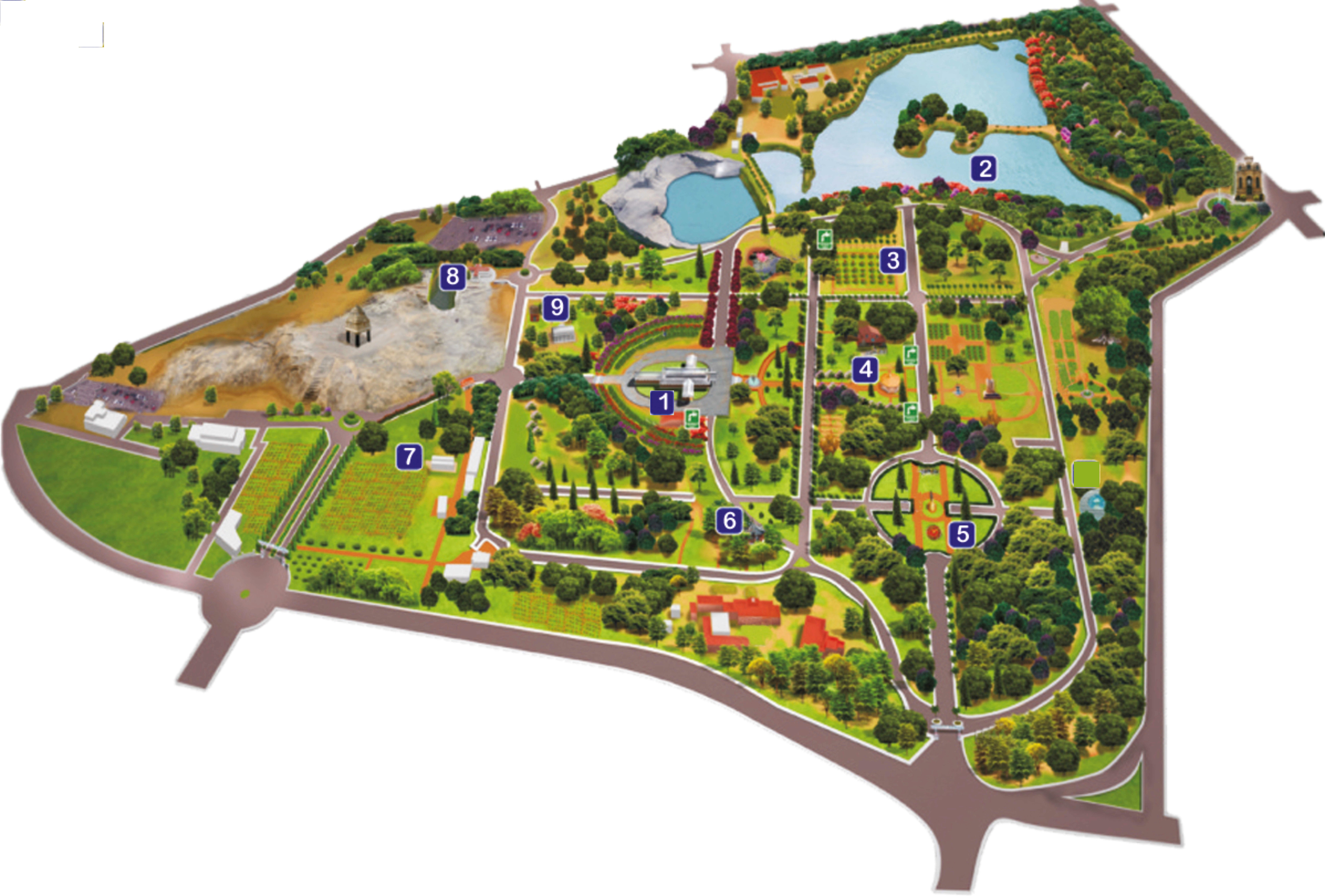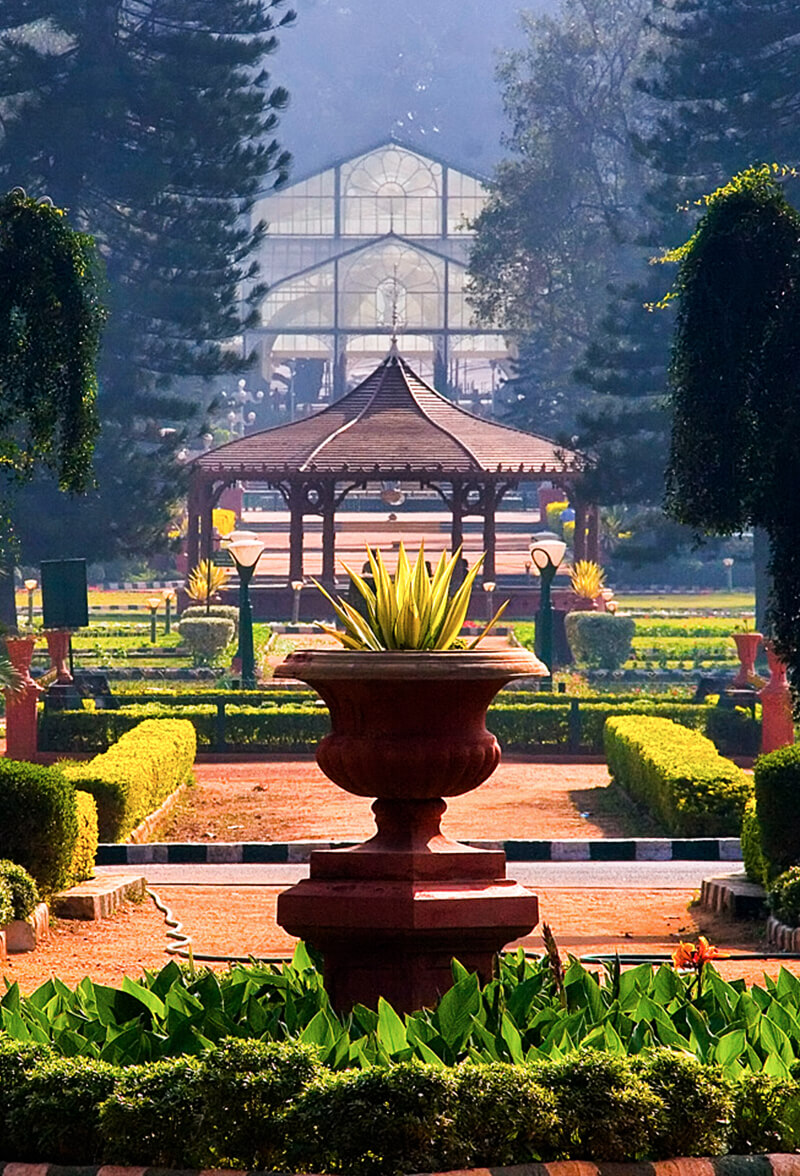Lal Bagh Bangalore
Description
About: Lal Bagh
History
Hyder Ali had this garden built in 1760 but it was completed by his son Tipu Sultan. lal Bagh is Hindustani for garden, while the reference to the prefix Lal is debated and could refer to the color red due to its original floral composition, but Lal also means "beloved". Hyder Ali decided to create this garden on the lines of the Mughal Gardens which were gaining popularity during his time. Hyder Ali established these famous botanical gardens and his son Tipu Sultan added horticultural wealth to them by importing trees and plants from several countries.
Hyder Gardens and Tipu's Lal bagh were managed by Mohammed Ali and his son Abdul Khader and were based on the design of the Mughal Gardens that once stood at Sira, 120 km from Bangalore. At the time, Sira was the seat of the strategically important southernmost Mughal "suba" (province) in the Deccan before the British Raj.
The Lal bagh Gardens were established in the 18th century; over the years it acquired India's first grass clock and the largest collection of rare plants in the subcontinent. After the conquest of the Kingdom of Mysore by the British in 1799, the garden was under the management of Major Gilbert Waugh, the Company's paymaster, and in 1814 its control was transferred to the Government of Mysore, with Waugh's appeal to the Marquess of Hastings that it should be under the Botanic Gardens at Fort William, Calcutta.
This was accepted and the charge of superintendence was given to Nathaniel Wallich on April 24, 1819. This continued until 1831 when the charge shifted to the Mysore Commissioner. The Agricultural and Horticultural Society was formed with William Munro, an army officer and amateur botanist in charge of the Bangalore branch. The Society wrote to the Commissioner of Mysore, Sir Mark Cubbon, requesting the management of the Lal bagh Garden. Cubbon granted control and was used for horticultural training during this period. The Bangalore chapter of the Society was dissolved in 1842, leaving the gardens unmanaged.
In 1855, Hugh Cleghorn was appointed Botanical Adviser to the Commissioner of Mysore. Cleghorn and Jaffrey, superintendent of the Madras Horticultural Society, looked at various sites for a horticultural garden and found that Lal bagh suited their purpose despite its distance from Cantonment, the British center of the city. He proposed that a European Superintendent be appointed with control under the Chief Commissioner.

Image source:- https://horticulturedir.karnataka.gov.in/
Cleghorn opposed the use of Lal bagh for commercial enterprise and suggested instead that the focus should be on improving the use of native plants, helping to introduce useful exotic species and helping to exchange plant and seed materials with other gardens in Madras, Calcutta and Ooty. . On Cubbon's orders, Lal bagh was converted into a government botanic garden in August 1856, and a professional horticulturist was sought at Kew. William New was recommended and he arrived in Bangalore on 10 April 1858. New's contract expired in 1863-64 and he was replaced by Allan Adamson Black, who worked at the Kew Herbarium.
However, Black suffered from ill health and resigned in 1865. He died after visiting his brother in Rangoon aboard HMS Dalhousie off the Cocos Islands on 4 December 1865. A new one was then appointed again. His 1861 catalog of Lalbagh plants included many economic and ornamental plants including cinchona, coffee, tea, macadamia nuts, hickory, pecans, rhododendrons, camellias and bougainvillea.

New died in 1873 and was succeeded by John Cameron, also of Kew. Cameron had the additional support of the Maharaja of Mysore, who was appointed in 1881, and introductions included Araucarias (A. cookieii and A. bidwilli), cypresses (Cupressus sempervirens), topiaries made from Hamelia patens.
In 1890-91, a central music stage and greenhouse (for floral displays) made of iron columns cast by Walter Macfarlane and Company of Glasgow were added. Cameron also helped introduce commercial crops such as cabbage, cauliflower, turnips, radishes, rhubarb, celery and kohlrabi. Featured trees included the baobab from Africa, Brownea rosea from the Caribbean, and Catha edulis from Yemen. Cameron left in 1908 and was succeeded by Gustav Herman Krumbiegel. A menagerie and an aviary were established in the 1860s.

A dovecote or dovecote for 100 birds was built. After the plague, maintenance deteriorated and in the 1920s there was a proposal to close the menagerie and aviary. in 1914. Captain S.S.Flower reported that it included a courtyard built between 1850 and 1860 with tigers and rhinoceroses; aviary; monkey house with orangutan; an enclosure with blackbuck, chital, sambar deer, barking deer and a pair of emus; a beararium and a peacock enclosure.
In 1874, Lalbagh had an area of 45 acres (180,000 m2). In 1889, 30 acres were added to the eastern side, followed by 13 acres in 1891 including Kempegowda Tower Rock, and another 94 acres in 1894 on the eastern side just below the rock, bringing the total to 188 acres (760,000 m2). The foundation stone for the Glass House, modeled after London's Crystal Palace, was laid on 30 November 1889 by Prince Albert Victor and was built during the time of John Cameron. It was built in cast iron from the Saracen Foundry in Glasgow UK. This structure was extended in 1935, this time with steel from the Mysore Iron and Steel Company at Bhadravati.
The Horticulture Department has decided to close the Lalbagh Botanical Gardens on Saturday 21 March 2020 to prevent public gatherings due to the COVID-19 pandemic. In the third week of May, the government allowed parks to be open only from 7:00 a.m. to 9:00 a.m. and 4:00 p.m. until 7 p.m.
There are more places to visit in Bangalore;
- https://yesnearme.com/business/commercial-street-bangalore-shopping/
- https://yesnearme.com/business/tipu-sultan-palace-bangalore/
YesNearMe Social media:- instagram
Contact Information
Contact Listings Owner Form
Review
Login to Write Your ReviewThere are no reviews yet.

